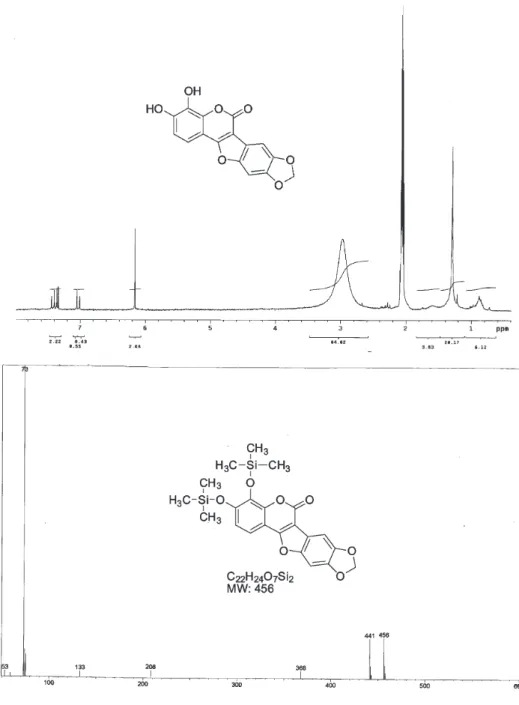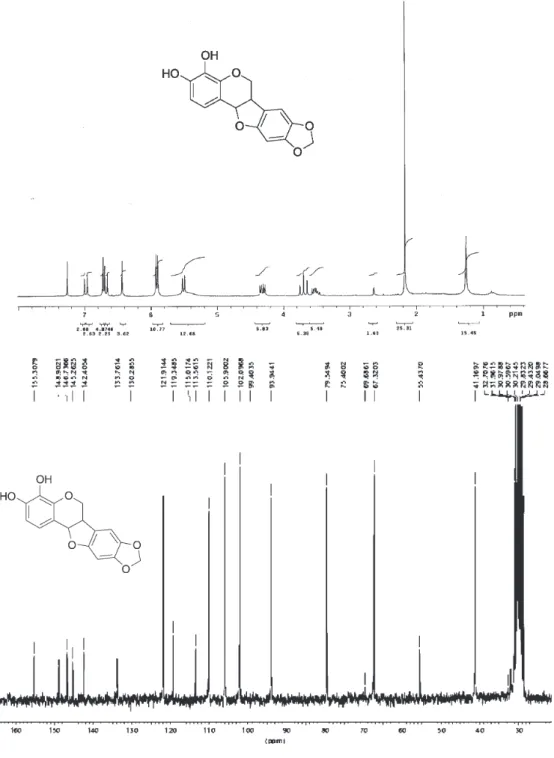J. Braz. Chem. Soc., Vol. 15, No. 6, 979-981, 2004. Printed in Brazil - ©2004 Sociedade Brasileira de Química 0103 - 5053 $6.00+0.00
S
ho
rt
R
e
p
o
rt
* e-mail: lqb@nppn.ufrj.br
The First Synthesis of (±)-3,4-Dihydroxy-8,9-methylenedioxypterocarpan, an Antitumoral
Agent and its Coumestan Derivative
Alcides J. M. da Silva, Chaquip D. Netto and Paulo R. R. Costa*
Núcleo de Pesquisas de Produtos Naturais, Centro de Ciências da Saúde, Bloco H, Universidade Federal do Rio de Janeiro, 21.941-590 Rio de Janeiro - RJ, Brazil
Apresentamos a primeira síntese do (±)-3,4-diidroxi-8,9-metilenodioxipterocarpano, um isoflavonóide natural que apresenta atividade antitumoral. A etapa chave envolveu uma arilação de Heck entre o 7,8-dibenziloxicromeno e o organomercurial derivado do sesamol, seguido de reação de desbenzilação. O aduto de Heck foi também empregado na síntese do correspondente derivado cumestano, utilizando DDQ como agente oxidante.
We report the first synthesis of (±)-3,4-dihydroxy-8,9-methylenedioxypterocarpan, a natural isoflavonoid that shows antitumoral activity. The key step involved the Heck reaction between the 7,8-dibenzyloxychromen and the organomercurial derived from sesamol, followed by debenzylation. The Heck adduct was also employed in the synthesis of the corresponding coumestan derivative, using DDQ as oxidant agent.
Keywords: isoflavonoids, pterocarpan, DDQ, antitumoral agents, coumestan
Introduction
A great number of naturally occurring biologically active flavonoids is described in the literature. In the area of antitumor drug discovery, some flavonoids derivatives ( chalcones, flavones, isoflavones, rotenoids etc. ) were shown to be active in vitro and in vivo.1 At the present
time, cancer claims the lives of more than seven million people worldwide on an annual basis. Thus, the development of new cancer treating drugs is a must.2 In
1995, Wall et al. isolated three pterocarpans from
Petalostemon purpureus (Figure 1).3 Compound (+)6aS,
11aS -3,4-Dihydroxy-8,9-methylenedioxypterocarpan (1) was active in a standard in vitro DNA strand-scission assay, and presented cytotoxity toward KB tumor cell line (ED50 = 0.9 µg mL-1). Pterocarpans(2)and maackiain(3)
[(+)-6aS,11aS
-4-hydroxy-3-methoxy-8,9-methylene-dioxypterocarpan] were found to be moderately active for KB cells (ED50 values of 4.0 µg mL-1 and 5.6 µg mL-1,
respectively), but inactive in the DNA strand-scission assay. Since these compounds have the same pterocarpan skeleton and differ only in the pattern of substitution in ring A, we
believe that the cathecol moiety in compound 1 is
important for antitumoral activity. The enantiomers of 1 e
2 were also previously isolated from plants,4 while 3 has
been isolated only as a racemate. 5
As part of a program aimed at synthesizing biologically active anticancer products,6,7 we describe the first racemic
synthesis of the natural product 3,4-dihydroxy-8,9-methylenedioxypterocarpan (1) and its derivative, 3,4-dihydroxy-8,9-methylenedioxycoumestan (13).
Results and Discussion
The key step6,7 in our strategy to prepare compound 1
wasthe coupling of chromen 8 and the organomercurial 9 derived from sesamol.8 The chromen was synthesized using
2,3-dimethoxybenzaldeyde (4) as starting material.
Treatment of 4 with BBr3 at –78 oC gave the cathecol
derivative in an excellent yield.9 This compound was
980 Silva et al. J. Braz. Chem. Soc.
oxidation using MCPBA. O-alkylation of the resulting phenol was acomplished by using 3-iodopropanal dimethylacetal, furnishing compound 7. Cyclization of 7 in acid medium led to chromen 8 in good yield (Scheme 1).
Compound 8 was allowed to react with 9 in the presence of lithium tetrachloropalladate II and acetone leading to cis-(±)-O–di-benzyl-pterocarpan 10.10 Finally, natural
product 1 was obtained by hydrogenolysis of the benzyl groups using the catalytic amount of Pd-C (10% m/m) and all the spectroscopic data were similar to those observed in the natural product.3 We also observed the clevage of
the furan ring when an excess of Pd-C was used, to yield product 11. (Scheme 2).
Oxidation of the 3,4-di-O-benzyl-pterocarpan 10 with DDQ in THF at room temperature for 4 h led to the intermediate 3,4-di-O-benzylated coumestan 12, which precipitated out of the solution, and was collected by filtration. The presence of the conjugated system in 12 was clearly showed by the batochromic shift observed in
the UV spectrum.11 The synthesis of coumestan 13 was
acomplished by hydrogenolysis of the protecting benzyl groups in 12 ( Scheme 3).
In summary, we have, for the first time, prepared natural pterocarpan 1 and its derivatives 11 and 13 in good overall yields. These compounds will be evaluated as antitumoral agents.
Experimental
General
Melting points were measured with a Fisher-Johns (Fisher Scientific Co) apparatus. Flash chromatography was performed using Merck silica gel 60, 230-400 mesh and Merck silica 60F 254 sheets. 1H NMR and 13C NMR
were recorded on a Varian Gemini-200 instrument.
cis-(±)-3,4-di-O-benzyl-Pterocarpan(10)
To a mixture of PdCl2 (87 mg, 0.49 mmol) and LiCl (42
mg, 1.0 mmol) in acetone (5 mL) was added chromen 8
(158 mg, 0.46 mmols) in acetone (10 mL). This mixture was stirred for 15 min at 0 oC and then
2-chloromercurio-4,5-methylenedioxyphenol (172 mg, 0.42 mmol) in acetone (10 mL) was added. The suspension thus obtained was stirred for 12 h at 25 oC. After this time, brine (150 mL)
was added to it and the mixture was extracted with acetyl acetate (3 x 50 mL), the organic extract dried (Na2SO4), and submitted to column chromatography to give the compound as a solid (128.6 mg, 56 %), mp. 170 oC.
1H NMR (CDCl
3) (200 MHz) δ 7.38(10H, m,); 7.18(1H,
d, J 8.6 Hz); 6.7(1H, d , J 8.6 Hz); 6.7 (1H,s); 6.42(1H, s); 5.9(2H, 2s); 5.48(1H, d, J 6.3 Hz); 5.1(4H, 2s); 4.3(1H, dd, J 6.0, 3.6 Hz); 3.6(2H, m). 13C NMR CDCl
3 (200 MHz) δ
39.92 (CH); 66.39 (CH2); 70.87 (CH2); 75.00 (CH2); 78.33 (CH); 93.55 (CH); 101.07 (CH2); 104.59 (CH); 107.81 (CH); 114.26 (C); 117.65 (C); 125.36 (CH); 126-130 (10 CH); 136.73 (C); 137.43 (2 C); 141.52 (C);147.88 (C); 149.74 (C); 152.72 (C); 153.94 (C). LRMS (EI) m/z 480 (M+), 389,
91(base). IR (KBr) νmax/cm
-1: 3065 – 3031 (aromatic H),
1613 (aromatic ring).
Scheme 3. Reagents and conditions: a) DDQ 2 mmol in THF; rt; b) H2, Pd-C (10% m/m), 3 atm, acetone, 70%.
Scheme 2. Reagents and conditions: a) PdCl2 / LiCl, acetone, 55%; b) H2, Pd-C (10% m/m), 3 atm, acetone, 100%; c) H2, Pd-C (excess), 3 atm, acetone, 60%.
981 The First Synthesis of (±)-3,4-Dihydroxy-8,9-methylenedioxypterocarpan
Vol. 15, No. 6, 2004
cis-(±)-3,4-Dihydroxy-8,9-methylenedioxypterocarpan(1)
3,4-di-O-benzyl-pterocarpan 10 (31.8 mg, 0.07 mmol) in acetone was hydrogenated (3 atm) in the presence of Pd-C (10% by weight). After 30 min. the catalyst was filtered to give (21.0 mg) in 100% yield. 1H NMR (CDCl
3) (200
MHz) δ 7.0(1H, d, J 8.5Hz); 6.73(1H, s); 6.68(1H, d, J 8.5 Hz); 6.44(1H, s); 5.92(2H, 2d, J 5.12 and 5.5 Hz); 5.5(1H, d, J 6.8 Hz); 4.32 (1H, dd, J 10.7 and 4.8 Hz); 3.7(1H, t , J 10.6 Hz); 3.57(1H, m). 13C NMR (CD
3)2CO (200 MHz) δ
41.14(CH), 67.83 (CH2), 79.53 (CH), 93.90 (CH), 102.05 (CH2), 105.87 (CH), 110.09 (CH), 113.52 (C), 119.31 (C), 121.87 (CH), 133.72 (C), 142.38 (C), 145.22 (C), 146.71 (C), 148,85 (C), 155,27 (C). LRMS (EI) m/z 300 (M+), 175,
162(base), 150. IR (KBr) νmax/cm
-1: 3513 and 3442 (OH),
3234-3031 (aromatic H), 1667 (aromatic ring). UV λmax/nm
(MeOH): 310.
3,4-Dihydroxy-8,9-Methylenedioxycoumestan(13)
To a solution of 10 (44.1mg, 0.09 mmol) in THF (3.5 mL) was added DDQ (41.3 mg, 0.18 mmol). The resulting mixture was stirred at room temperature for 12 h. The
intermediate 3,4-di-O-benzylated coumestan 12
precipitated out of solution and it was collected by filtration and washed with cold hexane. The crude product was allowed to react with hydrogen (2 atm) in acetone for 6 h. After this time the catalyst was filtred (CELITE) and concentrated in vacuo to furnish a amorphous solid 13 (13.6 mg, 54.5%). 1H NMR δ 7.42(1H, d, J 8.42 Hz);
7.36(1H, s); 7.34(1H, s); 7.02(1H, d, J 8.42); 6.16(2H, s). LRMS (EI, after derivatization with BSTFA + 1% trimethylchlorosilane)12 m/z 456 (M+), 441. IR (KBr)
νmax/cm
-1: 3435 (OH), 2921 (aromatic H), 1718 (C=O),
1632-1457 (aromatic ring). UV λmax/nm (MeOH): 348.
Electronic Supplementary Information
1H NMR, 13C NMR and mass spectra for compounds 1
and 13 are available as PDF file at http://jbcs.sbq.org.br.
Acknowledgements
Our research was supported by grants from PRONEX (No. 41.96.0888.00), FAPERJ, FUJB-UFRJ and CAPES. A.J.M.S is a postdoctoral fellow of FAPERJ (No. 26/ 151.081/97) and C.B.N. of CAPES fellowships. Central Analítica NPPN-UFRJ for the analytical data.
References
1. Pezzuto, J. M.; Phytochemistry of Medicinal Plants, Plenum Press: New York, 1995.
2. Murray, A.; Hunt, T.; The Cell Cycle: An Introduction, Oxoford University: EUA, 1993 ; Weinberg, R. A.; Sci. Am. 1996, 275, 62.
3. Wall, M. E.; Wani, M. C.; Brown, D. M.; Fullas, F.; Huang, L.; Chaudhuri, S. K.; J. Nat. Prod. 1995, 58, 1966.
4. Gottlieb, O. R.; Sutheerland, I. O.; Ollis, W. D.; Cook, J. T.; Phytochemistry 1978, 17, 1419; Ohyama, M.; Tanaka, T.; Iinuma, M.; Jr., C. L. B.; Chem. Pharm. Bull. 1998, 46, 663. 5. Mcmurry, T. B. H. ; Martin E.; Phytochemistry 1972, 11,
3283.
6. da Silva, A. J. M.; Costa, P. R. R.; Aurelian, L.; Noel, F.; Buarque, C. D., Brito, F. V.; Souza, D. V.; Murakami, Y. L. B.; Melo, P. A.; Silva, N. M. V.; Caruso, R. R. B.; Castro, N. G.; Macedo, L. F.; Malkas, L.; Hichey, R.; Bioorg. Med. Chem.
2002, 10, 2731.
7. da Silva, A. J. M.; Costa, P. R. R.; Coelho, A. L.; Simas, A. B. C.; Tetrahedron Lett. 2001, 42, 4111; da Silva, A. J. M.; Costa, P. R. R.; Noel, F.; Buarque, C. D., Brito, F. V.; Souza, D. V.; Rodrigues, V. P.; Melo, P. A.; Silva, N. M. V.; Albuquerque, E. X.; Bioorg. Med. Chem. Lett. 2001, 11, 283; Costa, P. R. R.; Coelho, A. L.; Simas, A. B. C.; Synthesis 1999, 6, 1017; Lichtenfels, R. A.; Coelho, A. L.; Costa, P. R. R.; J. Chem. Soc., Perkin Trans. 1 1995, 7, 949; Coelho, A. L.; Vasconcellos, M. A. A.; Simas, A. B. C.; Rabi, J. A.; Costa, P. R. R.; Synthesis
1992, 10, 914.
8. Breytenbach, J. C.; Rall, G. J. H.; J. Chem. Soc., Perkin Trans. 1 1980, 8, 1804.
9. Eisenbraun, E. J.; Vickery, E. H.; Pahler, L. F.; J. Org. Chem.
1979, 24, 4444.
10. Horino, H.; Ione, N.; J. Chem. Soc. Chem. Commun. 1976, 13, 500.
11. We have synthetized several pterocarpans and coumestans and in all cases a similar batochromic shift was observed (ref. 6). See also Spencer, R. R.; Bickoff, E. M.; Lundin, R. E.; Knuckles, B. E.; J. Agr. Food Chem. 1966, 14, 162.
12. Villamor J.L.; Bermejo A.M.; Tabernero M.J.; Fernandez P.; Analytical Lett. 2004, 37, 517.
Received: January 6, 2003
J. Braz. Chem. Soc., Vol. 15, No. 5, 1-2, 2004. Printed in Brazil - ©2004 Sociedade Brasileira de Química 0103 - 5053 $6.00+0.00
S
u
p
p
le
m
e
nta
ry
M
a
te
ri
a
l
* e-mail: lqb@nppn.ufrj.br
The First Synthesis of (±)-3,4-Dihydroxy-8,9-methylenedioxypterocarpan, an Antitumoral
Agent and its Coumestan Derivative
Alcides J. M. da Silva, Chaquip D. Netto and Paulo R. R. Costa*
Núcleo de Pesquisas de Produtos Naturais, Centro de Ciências da Saúde, Bloco H, Universidade Federal do Rio de Janeiro, 21.941-590 Rio de Janeiro - RJ, Brazil
2 Silva et al. J. Braz. Chem. Soc.


